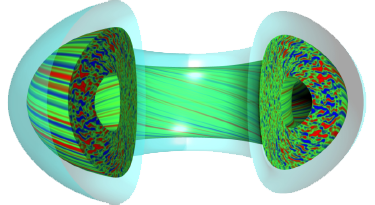Speaker
Description
Tractable and accurate prediction of tokamak plasma temperature, density and rotation profiles is vital for interpretation and preparation of current-day fusion experiments, optimization of plasma scenarios, and designing future devices. Predictions can be made using so-called integrated modelling suites, a collection of codes describing different physical processes integrated together to create a “virtual tokamak”. The complexity of theory-based models, vital for accuracy, is often the computational bottleneck, leading to up to weeks of simulation time for a single scenario in extreme cases. This means a significant speed-up is needed to enable use cases like inter-shot predict-first optimization and large scale optimization exercises. In this work, a neural network regression of the quasilinear gyrokinetic turbulent transport model QuaLiKiz is used to accelerate by orders of magnitude the prediction of transport fluxes.
The QuaLiKiz [1, 2] model has been verified against its non-linear counterparts in wide regimes. Combined with the JINTRAC integrated modelling suite [3] it has provided validated prediction of JET and AUG scenarios, with 1s of plasma evolution predicted in ∼24 hours using ∼10 cores [4, 5]. Previous work presented the QLKNN-hyper-10D model, a feed-forward neural network model trained on a database consisting of 300 million QuaLiKiz flux calculations over an rectilinear grid of dimensionless input parameters [6, 7]. This model can be evaluated under a millisecond, sufficient for real-time turbulent transport prediction. When used as a drop-in replacement for QuaLiKiz this results in simulation times of mere minutes while still being able to reproduce kinetic profiles within 1%-15% compared to the original QuaLiKiz model. In this work various extensions to the QLKNN family of models are presented. Firstly, the QLKNN-hyper methodology is extended with a new dataset consisting of 3 billion calculations, increasing the input dimensionality of the model with scans over the impurity density gradient. Combined with the addition of impurity fluxes to the output dimensions, this enables large scale studies on impurity transport, fuelling, and impurity seeding. Secondly, a QLKNN model trained on a database based on experimental JET data, QLKNN-jetexp-15D [8], is presented. By reducing the input subspace, a larger number of input dimensions is feasible, leading to more accurate predictions with a far smaller dataset, but limited to dimensionless parameters similar to JET. Several examples within the JINTRAC suite are shown. Thirdly, the QLKNN model has been integrated in the control oriented plasma simulator RAPTOR [9, 10]. The availability of analytic Jacobians of the input-output mapping of QLKNN enables its direct application in implicit solver schemes for fast PDE evolution, as well as for trajectory optimization and stationary-state solvers. An optimization of the ECCD deposition profile in ITER hybrid scenario’s is shown using these techniques [11]. Finally, all QLKNN models capture known physical features of tokamak turbulence, such as sharp instability thresholds common to all transport channels. Previous work includes these features by a physics-based cost function. However, superior regression results can be obtained by including the physical constraints directly into the neural network architecture, of which examples are shown.
The QLKNN family of models allow for simulations based on first-principle, within a fraction of simulation time. This opens the pathway for accurate and tractable full-device tokamak simulation, a longstanding challenge in the fusion
simulation community.
| Country or International Organisation | Netherlands |
|---|---|
| Affiliation | TU/e |

